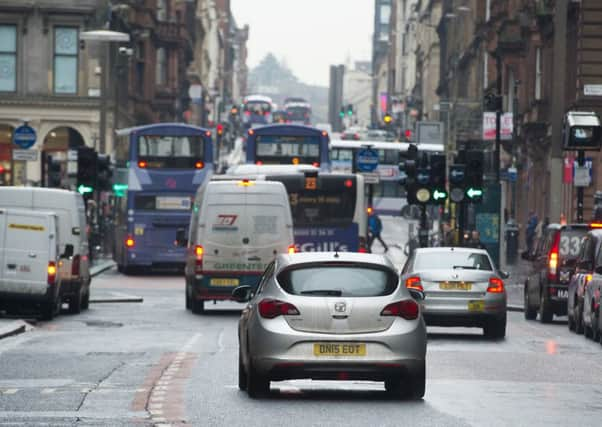Leaders: Target emissions not roads that suffer them


The Scottish Parliament voted last year to outlaw smoking in cars that are carrying children. The case for the ban is obvious: it aims to protect children from the harmful effects of second-hand smoke.
As with any curb on civil liberties, the restriction was controversial, but the logic behind the ban is simply to improve children’s health.
Advertisement
Hide AdAdvertisement
Hide AdInside the car? We’re getting there. But outside the car, we’re idling. In a built-up area.
The Scottish Government has been criticised for delaying proposals for low emission zones, on our streets where the worst pollution has been recorded. There is a tendency to think of air pollution as a problem for overcrowded London, where the visible evidence of smog and grime leave the visitor in no doubt about the poor air quality. However, while Scotland’s problem might be less pronounced, it remains deadly. It is estimated that more than 2,000 deaths a year in Scotland are caused by exposure to air pollution in our streets.
In an age of unprecedented environmental awareness, we have been slow to address the damage being caused to the public on the worst of our busy streets, such as St John’s Road in Edinburgh and Hope Street in Glasgow, where the traffic is heavy and the infrastructure not conducive to air pollution dispersal.
Now it has emerged that the Scottish Government’s pledge to introduce low emission zones by 2018 is likely to slip back until 2020 in practical terms, when the zones become operational.
Opposition party criticism of the timetable is inevitable, and the Scottish Government should indeed be held to account on such matters – particularly manifesto pledges which were drawn up to attract votes.
However, we should also consider just how effective low emission zones will be. While they are operated in parts of Europe, are they appropriate for all our circumstances? Our most heavily polluted streets are traffic corridors, used by buses and distribution vehicles serving densely populated urban areas. If these vehicles have to travel on alternative routes, the problem is merely transferred elsewhere, to residential areas. And the designs of our inner cities can be prohibitive when it comes to attempts to disperse traffic congestion, as we have found already with the knock-on effect of introducing pedestrianised areas.
The only real answer to reducing pollution in our streets is to lower emission rates from vehicles in the first place. And for those older vehicles which do not meet modern production specifications, bans have to be wider than one-off hotspot problems which only displace the problem.
Emissions do have to be tackled, but the vehicle industry is making huge strides with hybrid and electric vehicles. The value from low-emission zones has to be questioned when the money could be better spent on more effective measures to help the environment.
Labour did right thing, but too late
Advertisement
Hide AdAdvertisement
Hide AdIt’s not unusual for a new member of a club to be given only restricted rights or privileges, then becoming a full member after a specified period of time.
This sort of provisional status would have been an asset to the Labour Party, as it finds its membership rules the subject of legal scrutiny ahead of a leadership contest. The difficulty for Labour is that as the High Court has identified, subject to possible appeal, those new members who joined the party relatively recently cannot have such a condition applied to their rights retrospectively. If the rules were such that new members were allowed a vote in the leadership contest when they joined, then they should be given that vote.
However, beyond the current legal position, there is logic in the intentions of the National Executive Committee, which had decided that members could only vote in the forthcoming ballot if they had at least six months’ continuous membership up to 12 July – unless they paid an extra £25.
Allowing full voting rights immediately to those who join up leaves the party vulnerable to the leadership process being hijacked by a group or movement. So if the party has reason to believe that the spike in membership does not reflect the existing values of the party, there is a danger of a takeover.
No party should seek to dissuade new members, but are these members genuine Labour supporters, or are they people seeking the opportunity to turn the Labour Party into something else? If it is the latter, then existing membership rules do not serve the party’s interests, and should be changed.
The difficulty for Labour is that they realised too late in the day that they had left the gate open, and the horse has already bolted.